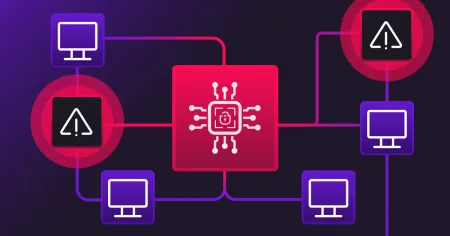Blog
Apr 30, 2025
When AI Becomes the Weak Link: Rethinking Supply Chain Security
AI is becoming a hidden entry point in supply chain attacks. Here’s why it matters and what organizations must do to stay protected.
7 min read

In 2020, IT management company SolarWinds unknowingly delivered malicious code to thousands of its customers, including major government agencies and private enterprises. The attackers had breached the company’s build environment and embedded their code into Orion, a widely used network monitoring platform. The poisoned update went out as normal. No red flags. No immediate panic. But it opened the door to one of the most far-reaching cybersecurity breaches in recent history.
What made the SolarWinds incident so impactful wasn’t just the technical sophistication; it was the strategy.
By targeting a trusted vendor, the attackers bypassed traditional security perimeters and gained access through the software supply chain itself. It was a wake-up call that reminded the world: even the most secure systems are vulnerable if one link in the chain is compromised.
Since then, the attack surface has only grown. Organizations rely on a vast web of third-party tools, services, and platforms to function. Increasingly, that includes artificial intelligence: embedded into everything from chatbots and customer analytics to security software and logistics management. These AI systems often depend on external models, APIs, and data pipelines that few teams scrutinize deeply.
And therein lies the risk. AI isn’t just a tool, it’s a dependency. When companies integrate third-party AI solutions, they inherit not just functionality but risk. A compromised model, a tampered training set, or a malicious package hidden in an open-source AI library can serve as a new entry point into the supply chain. The more organizations lean on AI, the more they widen the attack surface, often without realizing it.
While there isn’t yet a giant, SolarWinds-scale breach that directly weaponized a popular AI model or service as the attack vector, security researchers, threat intelligence teams, and major agencies have been warning about the growing risk. Let’s explore it.
When people think about cyberattacks, they usually picture someone going straight for the prize: hacking into a company’s servers, stealing customer data, holding systems for ransom. But supply chain attacks take a different route. Instead of storming the front gates, attackers slip in through the side doors—the ones that vendors, partners, and service providers leave open.
In cybersecurity terms, a supply chain attack happens when a threat actor compromises a trusted third party in order to reach their real target. It’s not just about hacking a single company; it’s about infiltrating the entire network of trust that the company relies on. The software updates they install. The cloud services they depend on. Even the hardware and firmware running behind the scenes. If attackers can quietly slip malicious code into a vendor’s update or steal credentials from a supplier, they can ride into the target organization almost unnoticed.
The targets in these attacks vary, but the theme stays the same: go where defenses are weakest. Software vendors are a favorite. So are cloud platform providers, firmware manufacturers, and any third-party service that businesses integrate deeply into their systems. Anywhere trust is assumed, attackers see an opportunity.
Supply chain attacks are patient, calculated, and devastating, and they thrive in environments where trust is a given and verification is an afterthought.
The idea of AI introducing supply chain vulnerabilities isn’t just a theoretical concern, it’s already happening, often in ways that are easy to miss until the damage is done.
One of the earliest warning signs came from the research community. In 2022 and 2023, studies from institutions like MIT and Berkeley showed that machine learning models, especially open-source ones, could be deliberately poisoned during training. A model might look completely normal in everyday use, but under the right conditions, it could behave in ways that open backdoors, leak data, or cause systems to fail. If an organization pulls in one of these compromised models without realizing it, they’re effectively inviting an attacker into their environment through a dependency they trust.
The risk isn’t limited to full models. Attackers have also been caught targeting the very building blocks of AI. In 2023, security researchers at Checkmarx uncovered malicious packages uploaded to popular open-source repositories like PyPI. These packages were disguised as helpful machine learning tools but hid remote access tools and data theft mechanisms underneath. Developers who downloaded them as part of their AI projects unknowingly compromised their own systems. It’s supply chain compromise, just wearing a different mask.
Even companies that don’t build their own AI models aren’t safe. Many organizations today plug into external AI APIs for everything from fraud detection to customer service automation. These APIs are often treated as trusted black boxes: useful, fast, and integrated deep into business processes. But if one of those providers were compromised, manipulated, or even just poorly secured, it could become a direct line into every client organization that depends on it. The risks here are real enough that OWASP’s AI Security guidelines now warn organizations to treat external AI APIs as critical third-party risks, requiring the same level of auditing and monitoring as traditional vendors.
Taken together, the evidence paints a clear picture: AI is weaving itself deeper into the fabric of supply chains. And without proper security controls, it’s becoming a new and dangerously overlooked attack surface.
The reality is, organizations aren’t going to stop using AI. If anything, they’re weaving it even deeper into their operations. The goal isn’t to retreat—it’s to move forward with caution, with better checks, stronger guardrails, and a clearer understanding of where the real risks lie.
First, companies need to treat AI integrations the same way they treat any other third-party dependency—with skepticism until proven otherwise. That means doing full vetting before bringing in an external AI model, tool, or service. It’s not enough to assume that because something is open-source, widely used, or offered by a known provider, it’s safe. Vet the model’s origin, scrutinize the data sources it was trained on, and if possible, run security testing against it before deploying it in production environments.
Second, organizations should harden their development and deployment pipelines. That includes using Software Bills of Materials (SBOMs) not just for traditional software, but for AI components too. Knowing exactly what models, datasets, and libraries are embedded in your systems—and tracking changes over time—makes it harder for malicious updates or poisoned models to slip through unnoticed.
Third, API integrations need to be treated with real caution. External AI services shouldn’t be given unchecked access deep into critical systems. Implement strict access controls, monitor API traffic for anomalies, and be ready to pull the plug if an external service starts behaving strangely. It’s about assuming that even trusted partners could be compromised—and building in the ability to respond quickly.
Fourth, organizations need to extend threat detection and monitoring to include AI behaviors. That means setting up systems that can spot when an AI model suddenly starts behaving in ways that weren’t part of its intended function. Unexpected outputs, unusual data requests, strange error patterns—these could be early warning signs of tampering or compromise.
Finally, it comes down to mindset. AI isn’t just a shiny tool to boost productivity or customer engagement—it’s part of your attack surface now. Security teams, procurement teams, developers, and executives all need to align on that reality. The organizations that bake AI risk management into their broader cybersecurity strategy now will be in a much stronger position when—not if—these threats become more common.
The supply chain was never supposed to be the battleground. It was supposed to be the foundation. But attacks like SolarWinds shattered that illusion, forcing organizations to rethink how deeply they trust the tools, vendors, and services they depend on. Now, AI is adding a new layer to that challenge.
The more we embed artificial intelligence into daily operations, from critical infrastructure to customer service, the more we unknowingly widen the cracks in the foundation. AI is no longer just a tool; it’s a dependency, and with that dependency comes real, measurable risk. Compromised models, poisoned packages, and vulnerable APIs aren’t distant possibilities, they’re risks already hiding in plain sight.
There’s no putting the genie back in the bottle. Organizations will continue to embrace AI because the benefits are real. But trust can’t be blind. Securing the AI supply chain means asking harder questions, demanding more transparency, verifying what’s under the hood, and building systems that assume no component is immune to compromise.
The next major supply chain attack may not come through a software update. It might slip in through a model, an API, or a package buried deep inside a machine learning pipeline. The organizations that recognize this now and take action will be the ones best prepared to face what’s coming.
Want to go deeper into the risks of AI in security? Explore our new LLM Red Teaming learning path and build the skills to probe, test, and secure large language models—before someone else does.
Stay in the know: Become an OffSec Insider
Get the latest updates about resources, events & promotions from OffSec!
Latest from OffSec

Research & Tutorials
CVE-2025-29927: Next.js Middleware Authorization Bypass
In this CVE blog, we explore a vulnerability in Next.js stemming from the improper trust of the x-middleware-subrequest header.
May 1, 2025
3 min read

Enterprise Security
When AI Becomes the Weak Link: Rethinking Supply Chain Security
AI is becoming a hidden entry point in supply chain attacks. Here’s why it matters and what organizations must do to stay protected.
Apr 30, 2025
7 min read

Research & Tutorials
CVE-2025-32433: Vulnerability in Erlang/OTP SSH Implementation
Read about a critical vulnerability found in the SSH implementation of Erlang/OTP arising from improper handling of SSH protocol messages.
Apr 23, 2025
3 min read